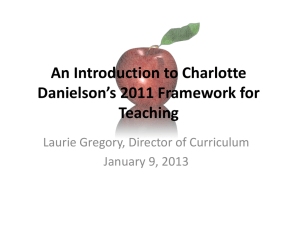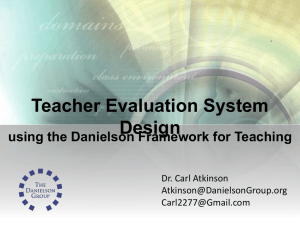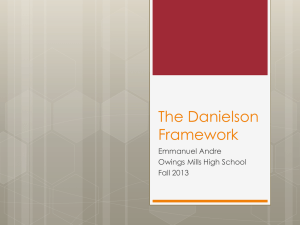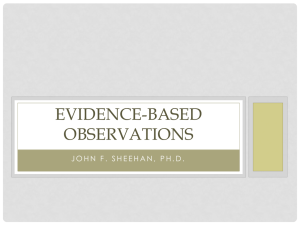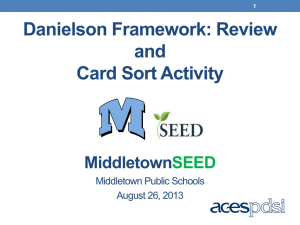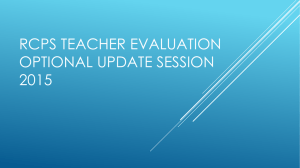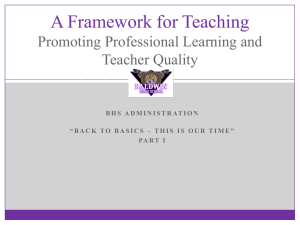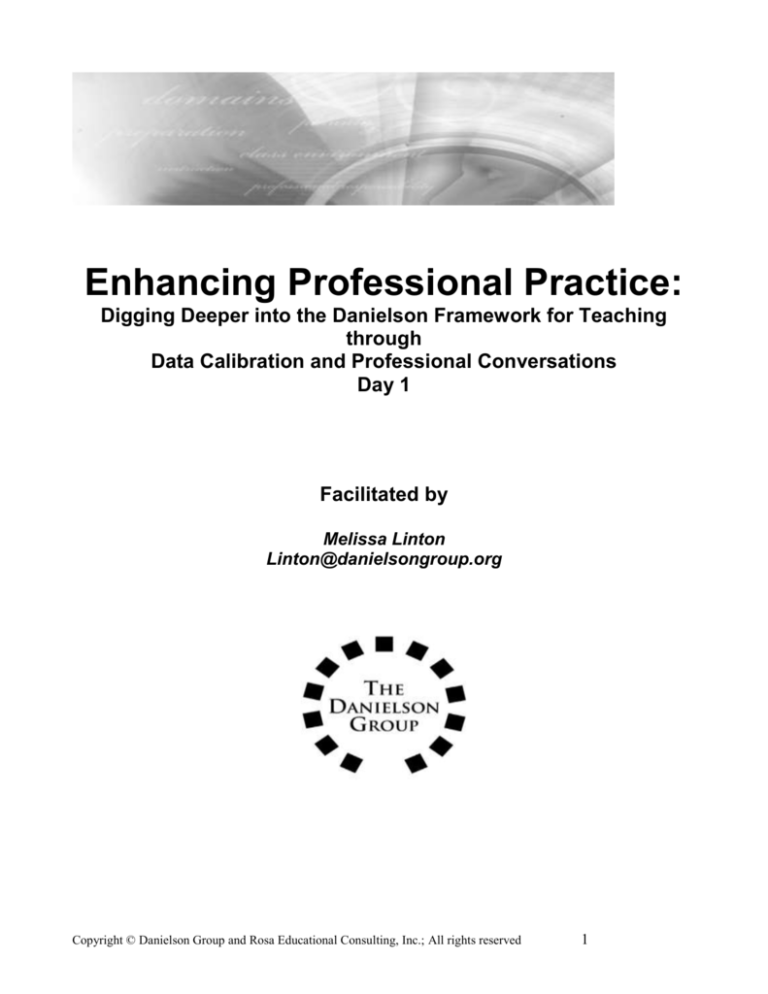
Enhancing Professional Practice:
Digging Deeper into the Danielson Framework for Teaching
through
Data Calibration and Professional Conversations
Day 1
Facilitated by
Melissa Linton
Linton@danielsongroup.org
Copyright © Danielson Group and Rosa Educational Consulting, Inc.; All rights reserved
1
The Danielson Framework for Teaching
Bold = 2013 FfT Components Aligned to Common Core
DOMAIN 1: Planning and Preparation
DOMAIN 2: The Classroom Environment
1a Demonstrating Knowledge of
Content and Pedagogy
1b Demonstrating Knowledge of Students
1c Setting Instructional Outcomes
1d Demonstrating Knowledge of Resources
1e Designing Coherent Instruction
1f Designing Student Assessments
2a Creating an Environment of
Respect and Rapport
2b Establishing a Culture for Learning
2c Managing Classroom Procedures
2d Managing Student Behavior
2e Organizing Physical Space
DOMAIN 4: Professional Responsibilities
DOMAIN 3: Instruction
4a Reflecting on Teaching
4b Maintaining Accurate Records
4c Communicating with Families
4d Participating in a Professional Community
4e Growing and Developing Professionally
4f Showing Professionalism
3a Communicating With Students
3b Using Questioning and Discussion
Techniques
3c Engaging Students in Learning
3d Using Assessment in Instruction
3e Demonstrating Flexibility and
Responsiveness
Evolution of the Framework for Teaching
1996: “Enhancing Professional Practice: A framework for teaching” published by ASCD.
2007: Second edition of “Enhancing Professional Practice: A framework for teaching” published by ASCD. It updated the
research base from the first edition. It also added a chapter providing frameworks for non-classroom specialists (school
nurses, librarians, etc.) who are typically part of a teacher bargaining unit but who, while they do some teaching,
typically do much more besides teaching.
2011: As a result of participating in several large research studies, notably the Measures of Effective Teaching (MET)
project funded by the Gates Foundation, it became clear that precision of language in the levels of performance was
critical for accuracy of judgment of teacher performance on the Framework for Teaching. The 2011 version of the
framework for teaching offered that greater precision, and also provided rubrics written at the component, rather than
the element, level. In addition, it added critical attributes and possible examples of each level of performance of each
component of the framework.
2013: The evolution of even more precise language continued with the 2013 edition of the framework for teaching
evaluation instrument; it also made explicit the instructional implications of the Common Core State Standards. From its
inception, the framework has always been built on the same conceptual base as the CCSS; the 2013 edition makes those
connections explicit.
Copyright © Danielson Group and Rosa Educational Consulting, Inc.; All rights reserved
2
Outcomes:
•
•
•
•
•
•
•
•
•
Focus on best practices for planning conferences
Distinguish between evidence and opinion
Be aware of (and control for) personal biases
Collect classroom-based evidence
Align evidence to components
Examine evidence against critical attributes
Determine level of performance
Focus on best practices for reflection conferences
Develop a rationale for rating
____________________________________________________________
Agenda:
Welcome and Framework for Teaching Connector
• Plan-Teach-Reflect-Apply (PTRA)
• The Collaborative Observation Process
• The Planning Conference
• Evidence vs. Opinion
• Minimizing Bias
• Evidence Collection
• Evidence Interpretation
• The Reflection Conference
________________________________________________
Collaborative Norms:
•
•
•
•
•
Equity of Voice
Attentive Listening
Safety to share different perspectives
Commitment to the work
Use face-to-face tech during session and phone/computer
tech during breaks
Copyright © Danielson Group and Rosa Educational Consulting, Inc.; All rights reserved
3
CONCEPT HARVEST
Level of Performance Domain 3
Unsatisfactory
4 Domains
Element
Heart of the
Framework
Proficient
Component
Basic
Low-Inference Data
Domain 1
Domain 2
Exemplary
Student Engagement On stage – Off Stage
Copyright © Danielson Group and Rosa Educational Consulting, Inc.; All rights reserved
4
The Professional Practice Improvement Cycle:
Quality Assurance and Professional Growth
Four steps characterize professional improvement:
Plan - Teach/Deliver Services - Reflect - Apply
Copyright © Danielson Group; All rights reserved
5
Domain 1 Priorities Conversation Protocol*
Clarify priorities for student learning and context for the lesson (1a, 1b, 1c).
Invite the teacher to talk about this lesson and it fits into the curriculum. Explore the context
and what has led up to it.
How is this lesson building on students’ backgrounds, knowledge, and experience?
What are your goals for student learning?
How are these learning goals related to the content standards, state frameworks, or
other district learning priorities?
How do these goals address individual student learning needs?
Determine evidence of success for student achievement (1f).
Inquire about the teacher’s expectations for students.
How are you formally assessing what students know and are able to do?
What assessment tool(s) will give you the data you need?
How has assessment guided the design of this lesson?
In what ways are students assessing their own learning?
What informal assessments of student learning might help adjust instruction while you
are teaching?
Purposeful planning of the lesson, including teaching strategies and
decisions made (1d &1e).
Ask the teacher to talk about the specifics of the lesson.
What priorities support your organization and sequence of instructional activities and their relationship
to the learning goals?
How is the lesson/unit scaffolded or differentiated to address the diverse learning needs of the
students?
How do parts of the lesson planning process (i.e., instructional and student learning resources,
student groupings, pacing, use of technology, classroom management priorities) adjustments for
specific learning needs of students, and where this lesson “sits” in the overall learning process.
Identify specific focus for data collection (Domain 2 and 3).
At the conclusion of the pre-observation conversation, ask or share specific teaching/student
learning priorities that will be/were specifically targeted during the observation.
What are you curious about regarding your classroom environment or instructional
practice?
What specific data might I collect for later conversation and reflection?
How might this evidence support your professional growth?
*Adapted from New Teacher Center MA 2: Day One and A. Costa and R. Garmston.
Copyright © Danielson Group; All rights reserved
6
Planning Conference Note-Taking Guide
Clarify priorities for student learning and context for the lesson (1a, 1b, 1c).
Determine evidence of success for student achievement (1f).
Explore planning, including teaching strategies and decisions made (1d &
1e).
Identify priority observation focus for data collection (Domain 2 and 3).
Lesson Planning Protocol
Copyright © Danielson Group All rights reserved
7
Teacher: Maria Reitano
Grade Level(s): 7th Grade
Evaluator: Mr./Ms Qualified Evaluator
School: Lakeview School
Subject(s): Language Arts
Date: February 28, 2014
Planning Priorities:
1.
2.
3.
4.
5.
6.
7.
8.
To which part of your curriculum does this lesson relate? (1a) Persuasive essay writing is a 7th grade writing standard
that focuses upon all students being able to write, at a proficient level, a multi-paragraph essay that includes a welldeveloped introductory and conclusion paragraph, three supporting paragraphs, and one opposing paragraph. All 7th
grade students are assessed on their ability to write a persuasive essay for the local language arts assessment.
How does this learning fit in the sequence of learning for this class?(1a/1e) Persuasive writing is a focus for all 7th
grade students and builds upon narrative and expository writing that is focused upon in 5 th and 6th grade. All 7th
Grade LA teachers work together to develop the same writing projects (e.g., country research project), MAP planning
tool, and rubric. Monthly, the LA teachers get together and grade each other students’ persuasive writing samples.
Briefly describe the students in this class, including those with special needs. (1b) Please reference the Student
Class Profile.
What are your learning outcomes for this lesson? What do you want the students to understand? (1c) The students
will be able to plan, write, and critique a multi-paragraph persuasive essay that includes a well developed
introductory and conclusion paragraph, three supporting paragraphs, and one opposing paragraph.
How will you engage the students in the learning? What will you do? What will the students do? Will the students
work in groups, or individually, or as a large group? Provide any worksheets or other materials the students will be
using. (1e/3c) The lesson is divided into five parts: 1) The introduction will ask the students to write in their journals,
responding to prompts: What might attract people to your country of study? What might you put on a travel
brochure for your country? 2) Direct Instruction will focus upon students working in groups to sort sentence strips
into sets of supporting details and topic sentences; 3) Guided Practice will include students planning their persuasive
essays using a graphic organizer; 4) Independent Practice provides students time to work individually to write their
persuasive essays; and 5) Closure will include a short sharing time based upon student writing. The MAP for
Persuasive Writing template has been attached to this document.
How will you differentiate instruction for different individuals or groups of students in the class? (1e/3c) Based
upon individual and group learning needs, I will differentiate my instructional support in the following ways: 1) During
whole group lesson, I will purposefully call on students to check their understanding of key concepts included in the
lesson. I will also differentiate my responses based upon the individual student responses. I would like to get
students in the classroom to be willing to share/guide other students thinking in the class so I will try to also call on
other students in the classroom to respond to their follow classmates’ questions; 2) During small group time, I will
move around from group to group, checking to see where individual or groups are having trouble completing the
different writing activities; and 3) When students have 25 minutes of writing time, I will be working one-on-one with
students to help give them ideas, strategies to use in their individual persuasive essay.
How and when will you know whether the students have learned what you intend? (1f/3d) I will be listening and
checking on individual and small group understanding as we go through the direct and guided practice. When the
students are finished writing their persuasive papers (they will have 2 days to write the initial paper and then one day
to revise/rewrite based upon my feedback), I will use the 7 th grade Persuasive Writing Rubric to check the different
parts of their writing.
Is there anything that you would like me to specifically observe during the lesson? (Domain 2 and 3)
I would like you to give me feedback on how well I connect with the students as a whole group and as individuals. I
have really been working on developing relationships with each of the students, so I hope that comes through in the
observation. I also would like to know how well I am communicating the main outcomes, activities, and learning
expectations as we go through the lesson.
Copyright © Danielson Group All rights reserved
8
CLASS PROFILE
Teacher: Ms. Maria Reitano
Grade: 7th Grade
Subject: Language Arts
1.
5. Is there anything about the overall learning
environment that you think might affect
your students or the scheduled observation
(e.g., that is not your own classroom; there is
new equipment or new pet in the room; there
is construction in the building)? Is so, please
note.
How many students will be observed?
[ 26 ] Total Number
[ 13 ] Male students
[ 13 ] Female students
2.
[ 12-14 ] What is the age range of students?
3.
Approximately how many students are in each of the
following language categories?
There were two fire drills last week
(students were setting them off) that
interrupted the students’ research on
their countries but the lessons this week
should be fine.
[ 17 ] English language proficient
[ 9 ] Limited English language
proficient
1.
6. What are the most important classroom
routines, procedures, rules, and expectations
for student behavior that will be in operation
during the observed lesson?
Approximately how many students have the following
exceptionalities?
[
] Blind or visually impaired
[
] Deaf or hearing impaired
[
] Developmentally disabled
[
] Emotionally or behaviorally
disabled
[ 03 ] Gifted
[ 06 ] Learning disabled
[
] Physically disabled
[
] Other (please specify)
2.
Students are usually pretty respectful of
each other and don’t shout out but raise
their hands and wait to be called upon.
Sometimes I have to motivate different
students to get involved in the class
discussions so I do things like thumbs
up/down or count off hands that are
raised. I used to have a problem with
students laughing and mimicking each
other or me but that has pretty much
ended.
With respect to the following categories, how would you
describe your students?
[
] African American / Black, nonHispanic
[
] Asian, Asian American, or Pacific
Islander
[ 13 ] Mexican American or Chicano
[
] Native American, Inuit, or Aleut
[ 03 ] Puerto Rican
[ 06 ] Other Hispanic
[ 04 ] White, non-Hispanic
[
] Mixed Race
[
] Other (please specify)
Copyright © Danielson Group All rights reserved
Observer:
Date of Observation: Sept 1, 2012
7. Are there any special circumstances that the
observer should be aware of in order to
understand what will occur during the
scheduled observation (e.g., school-wide
routines or policies, interruptions, behavior
patterns or students)? If so, please explain.
Students are sometimes called out of
class; the LD students have additional
support from the Special Education
teacher on Tuesdays and Thursdays;
team physicals are being held later this
week; some students arrive late to class
due to variety of reasons.
9
Student Name:
Date:
MAP for Persuasive Writing
Copyright © Danielson Group All rights reserved
10
Evidence vs. Opinion
Many observers of teaching confuse descriptions of classroom practice with opinions about
classroom practice. Opinions can be a reflection of one’s biases and personal preferences,
particularly when they are not supported by a collection of evidence. Descriptions (evidence) and
opinions differ in the following way:
Description of Classroom Practice (Observer records an event with no interpretation)
VS.
Opinion About Classroom Practice (Observer interprets an event based on own
beliefs about good teaching)
To consistently apply the rubric to observations of classroom practice, it is essential to be able to
make observations of evidence that stand independent of opinions (premature interpretations of
evidence that are based on personal beliefs).
EVIDENCE
OPINION
observable
draws conclusions
objective
subjective
free of value judgment
may include value judgment
Evidence Types:
Verbatim scripting of teacher or student comments:
“Would one person from each table come to collect the materials?”
“We have five more minutes to finish. Let’s look over our work before we hand it in!“
Non-evaluative statements of observed teacher or student behavior:
The teacher stood by the door, greeting students as they entered.
Students were seated at tables in groups of four, working independently.
Numeric information about time, student participation, resource use, etc.:
Three students offered 80% of the comments during the discussion.
Fifteen minutes was spent in circle time.
An observed aspect of the environment:
The assignment was on the board for students while attendance was taken.
There were three centers designed for independent work.
Copyright © Danielson Group All rights reserved
11
Bias Errors
Compare/Contrast Error
The tendency of a rater to evaluate a person relative to other individuals rather than on how well the
person fulfills the requirements of the job. For Example: Mrs. T uses the same routines in her classroom
as Mrs. V who is a master teacher. The rater generalizes from this similarity and looks for additional
positive examples during her observation. Mr. G is the only teacher who did not participate in the
voluntary staff development session. The raters negative judgment about this absence influences his
observation of the classroom.
Similar/Dissimilar to Me Error
The tendency of a rater to evaluate more favorably those people whom they perceive as similar to
themselves. For Example: Mrs. J’s has created a classroom that is just like the rater’s last work setting.
Therefore, the rater is more likely to look for positive examples during an observation. Mr. D frequently
reads the same books as the rater. This leads the rater to view Mr. D’s performance more positively. Mrs.
A has a similar accent to the rater. This leads the rater to view Mrs. A in a positive light.
Central Bias Error and/or Negative-Positive Error
The tendency of a rater to score people either at the extreme ends of the scale (too harshly or too
leniently) or close to the midpoint of a scale when their performance justifies a substantially higher or
lower rating. For Example: The rater never gives more than a 2 on anything or always gives 3’s on
everything.
I Know You Error
The tendency of a rater to allow previous history or present relationship to influence the score. For
Example: Mr. L has a long standing friendship with the rater, as they formerly co-taught a humanities
course. As a result, the rater is likely to look for positive performance examples. Mrs. P is
argumentative during staff meetings, so the rater is likely to look for negative examples in her
classroom.
Emotional State Error
The tendency of a rater to allow their present emotional state to influence the score. For Example: The
rater had an argument with her teenage daughter before leaving for work and her resulting mood
causes a negative lens on her observations. The rater got engaged over the weekend and his good
mood influences his observations positively.
Copyright © Danielson Group All rights reserved
12
Tips for Avoiding Bias
All performance ratings should be established against fixed standards, not compared to previous
performance, the ratings of others, initial impression or any factors other than the observable
evidence and the specific rubric.
Some tips to guide non-biased scoring include:
• Consider whether the person being evaluated has done anything unusually good or bad in the last few
months. Either situation can influence your thinking.
• Ask yourself whether you feel the person has a particularly pleasant or unpleasant personality and
whether this might be influencing your perspective regarding their job performance.
• Remember that it is unlikely that any staff member either “exceeds expectations” or “need
improvement” in every component.
• Study your ratings to determine whether you might be giving higher ratings to individuals more similar
to yourself. Be particularly alert for this problem when rating a staff member who is a good friend or with
whom you socialize.
• Study your ratings to determine whether you might be giving lower ratings to staff members who are
very dissimilar to you or whom you dislike.
Copyright © Danielson Group All rights reserved
13
Classroom Observation Documentation
Teacher:
Maria Reitano
Date / Time:
October 28, 2014
Evaluator:
Mr./Ms Qualified Evaluator
Subject Area:
7th Gr Language Arts
Domain 2: Classroom Environment
Domain 3: Instruction
2a - Creating an Environment of Respect and Rapport
2b – Establishing a Culture for Learning
2c - Managing Classroom Procedures
2d - Managing Student Behavior
2e - Organizing Physical Space
Time
3a - Communicating with Students
3b – Using Questioning and Discussion Techniques
3c - Engaging Students in Learning
3d – Using Assessment in Instruction
3e – Demonstrating Flexibility and Responsiveness
Actions & Statements/Questions by Teacher & Students
1
Introduction – Students write in their journals, responding to prompts: What might
attract people to your country of study? What might you put on a travel brochure for your
country? (7 minutes)
2
There are 6 student groups with 3-4 student desks in each group and all students can see the
front of the room/white board for reference.
3
T says, “Think for a moment that you are going on a vacation” and then T has the Ss think
about going to the travel agency and asks the Ss to imagine making a travel brochure for
their individual country that each of the Ss have been researching.
4
T asks questions like, What would that poster look like? What kind of information would
attract people to come to the country based upon the information that you have been
learning about? What might make people want to travel there?
5
T tells the Ss that they have to write 5 sentences in 5 minutes. T confirms that this direction
makes sense to the Ss.
6
7
8
9
The S says that there is nothing good about his country and that he doesn’t have anything to
write but T states that she thinks there is and asks the S to check his notes.
All Ss have their writing journals out on their desks and Ss have their research information
on their card rings.
T does a good job moving to 3 different groups to check on Ss who are working on their
writing and even sits down with one group to help.
T checks to see if any Ss need additional time to write. Five Ss raise their hands and the T
says, “Wow, we are in the mood to write today. Ok, let’s take 2 more minutes”.
Copyright © Danielson Group All rights reserved
14
Component
Classroom Observation Documentation
Types of Observation:
Time
Actions & Statements/Questions by Teacher & Students
Copyright © Danielson Group All rights reserved
15
Component
Time
Actions & Statements/Questions by Teacher & Students
Copyright © Danielson Group All rights reserved
16
Component
Classroom Observation Documentation
Teacher:
Maria Reitano
Date / Time:
October 28, 2014
Evaluator:
Mr./Ms Qualified Evaluator
Subject Area:
7th Gr Language Arts
Domain 2: Classroom Environment
Domain 3: Instruction
2a - Creating an Environment of Respect and Rapport
2b – Establishing a Culture for Learning
2c - Managing Classroom Procedures
2d - Managing Student Behavior
2e - Organizing Physical Space
Time
10
3a - Communicating with Students
3b – Using Questioning and Discussion Techniques
3c - Engaging Students in Learning
3d – Using Assessment in Instruction
3e – Demonstrating Flexibility and Responsiveness
Actions & Statements/Questions by Teacher & Students
Direct Instruction (12 minutes) – Students work in groups to sort sentence strips into sets
of supporting details and topic sentences.
11
T has the Ss check to see if everyone has a little packet of sentence strips. T pauses to let the
Ss respond.
12
T states that they are focusing upon the main idea and supporting details. T wants to check
to see if the Ss included primarily main ideas or supporting details
13
T asks the Ss to raise hands if they wrote about the climate of their country for their travel
agency ad. 5 Ss raise their hands and T calls on 1 S to answer.
14
T says, “Something that I have noticed is that lots of you have lots of great ideas but not lots
of supporting information.” T wants to check to see if Ss know the different between main
idea and supporting ideas.
15
The teacher uses the chart stand and large cards to model the sorting process to students in
the whole group.
16
T explains that the cards are “mixed up” from two different essays. T models that the first
job is to sort the cards into 2 groups. Students comply with T request immediately.
17
18
19
Ss check their two stacks and talk in their groups with each other.
When T asks if anyone has the one about milk, several Ss get super excited and start to
short out really loud, “Ooo! Ooo! Ooo!”
T uses thumbs up and thumbs down to take a vote when she hears a little disagreement. ~ T
says, “Some Ss are not sure…not sure (uses a ‘trembling voice’) ”.
Copyright © Danielson Group All rights reserved
17
Component
20
T calls on an individual S who had his thumb up about giving a supporting detail. T asks the
S to explain his thinking and the S gives an answer that doesn’t make sense but T asks the S
2 more follow-up questions while several Ss giggle in the background. Another S says
“Shhhh”. T keeps focus on the S’s explanation and does not say anything to the Ss in back.
21
T points out that on one of the cards that she has made a mistake and she tells them that
everybody makes mistakes.
22
T models raising her hand when Ss start to shout out and says, “We will do it like this” and
then has the Ss raise hands and counts off, “We have 1, 2, 3, 4, up to 9 Ss who know”.
23
“Still no?” T asks S why is it still no. S responds that it didn’t give additional information. T
asks if additional information is the only way that you can support the main idea. The S
seemed puzzled by that follow-up question.
24
25
26
27
T asks the Ss if they could “sort the cards in 2 minutes? No? Then 3 minutes” and several
Ss start to shout out and then T talks over the student voices and tells them to try to do it in
3 minutes.
Ss are working on sorting the cards and determining supporting details when 1 S gives her
thinking about linking details to an “example” and another S asks what is the main idea? All
Ss in the group check and see if they have the main idea correct.
Guided Practice: Students plan their persuasive essays using a graphic organizer (14
minutes)
Ss are “shhhhing” each other 4x during the Guided Practice.
28
29
30
31
32
33
T shows the graphic organizer. The T asks if this looks familiar and Ss choral respond
“Yes” and “No”.
T states that in 7th grade it is our job to learn about persuasive writing.
As T models the “mapping it out” section, a S asks if it is the same as the writing
assignment that they are doing for the research report.
The T’s explanation is totally confusing and the Ss seem to be even more confused that they
were before she explained the reason for the persuasive writing.
T walks around the groups and says that she notices that the Introduction boxes are empty
so she models on the overhead an introduction based upon the Japan.
T models what she thinks is a boring sentence then does a snore and many Ss smile.
34
S gives the example for the class that “Japan is the best place because of it’s climate” and T
says that S can even shorten that up to include just that Japan is the best and then don’t go
into “because, because, because”.
35
T gives 2 ways to start a sentence, but many Ss seem to be confused after T explanation. S
confirms confusion by saying, “I don’t get it”.
Copyright © Danielson Group All rights reserved
18
36
37
38
39
40
41
42
43
T asks the S to read her main idea and then see if the class can help. The S says that
“Germany is a good place to go in the summer” and then the T says, “So I am going to
guess that in the next 3 bubbles that you have explained why Germany is a good place to go
in the summer”. S nods her head but no other Ss were involved in the discussion.
When another S raised her hand and said that she didn’t know why they were writing this,
the T should have gone back to the main idea of lesson and had everyone write it at the top
of their paper.
1 S has a head down on the desk for 10 of the 14 minutes of the Guided Practice section
T sees that a S is playing with an object instead of writing and says, “I am going to hang
onto those because that seems like something that we are working on” – S does not respond
to the T.
A variety of different Ss are called upon during the whole lesson. T asks a S “that has been
a quiet person today” to share his thinking (several Ss giggle). The S seemed to be
embarrassed by the T’s statement and did not respond to teacher until prompted by another
question.
Independent Practice: Students work individually to write their persuasive essays (13
minutes)
T says to the class that they are going to have time to “make the ugly organizer into a
beautiful writing paper” which was a great way to lead into the independent work time.
Most Ss are using their graphic organizer to help write their papers (only 3 are not using it).
44
One S is making an elaborate header around the title but has nothing else on the paper
written and is not using the graphic organizer to plan writing of paper. The T walks by but
does not say anything.
45
Closure: Student shares persuasive writing (1 minute)
Copyright © Danielson Group All rights reserved
19
Professional Conversation Log
Celebrations? Based on the lesson and student work you
Concentrations? What aspects of instruction most need to
observed, what strengths in the teacher’s practice do you want to
highlight? (NOTE: Consider sharing how the strengths in planning
improve? Identify priority areas that will have the most
substantial impact on student learning, as well as the evidence
you will share to support them. (NOTE: You may choose to prioritize a
supported the effective teaching/student learning process in the lesson.)
component, or to select a priority that would address several components.)
Specific Feedback? (NOTE:
Consider feedback from planning
documents or observation data that will support focus on student learning and
instructional best practices.)
Copyright © Danielson Group All rights reserved
20
Next Steps/Resources? (NOTE:
Consider many different steps and
resources for addressing the area of concentration and then narrow down
steps that the teacher can commit to and do!)
Observation Note-Taking Form
Remember to capture:
What do you see and hear the teacher and students doing? Quantify and quote.
What evidence can you gather of student learning? Actively collect data.
What will students know and be able to do at the end of the lesson? Search out evidence of rigor and
new understandings from students.
Evidence of Student Outcomes
Examples of student outcome data can include: number of students who write down the correct answer, student
responses to probing questions about the lesson objective, specific answers given by students.
Time
Teacher Actions
Copyright © Danielson Group All rights reserved
Student Actions
21
Copyright ©Danielson Group All rights reserved
22
NOTES:
Copyright ©Danielson Group All rights reserved
23

